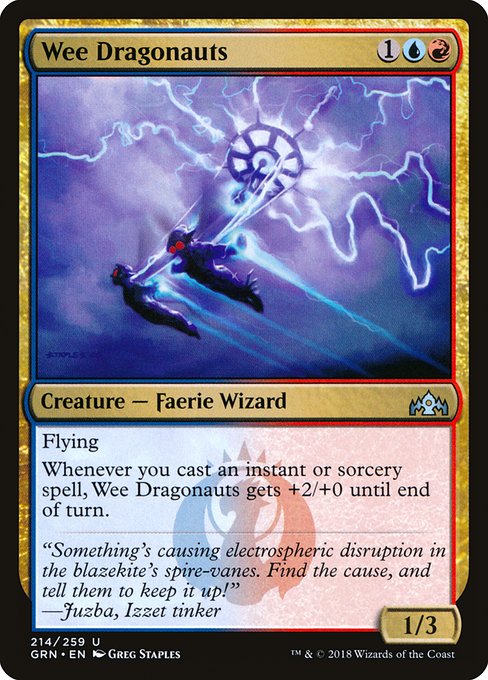
Image courtesy of Scryfall.com
Using Embeddings to Group Similar MTG Cards
Data-driven magic is more than a buzzword; it’s a practical way to map the sprawling universe of Magic: The Gathering into meaningful neighborhoods. Embeddings translate card text, mechanics, and metadata into dense vectors that capture similarity in a form a machine can understand—and that we humans can use to spot patterns we might miss on the kitchen-table level. Think of it as a way to arrange the multiverse on a spark-powered corkboard: where color, cost, and creature type once felt like separate threads, embeddings reveal how often certain concepts travel together in actual play. 🧙♂️🔥
Wee Dragonauts at a glance
- Name: Wee Dragonauts
- Mana cost: {1}{U}{R} (CMC 3)
- Type: Creature — Faerie Wizard
- Power/Toughness: 1/3
- Keywords: Flying
- Ability: Whenever you cast an instant or sorcery spell, this creature gets +2/+0 until end of turn.
- Set / Rarity: Guilds of Ravnica (GRN), uncommon, Izzet watermark
- Illustrator: Greg Staples
- Flavor text: "Something's causing electrospheric disruption in the blazekite's spire-vanes. Find the cause, and tell them to keep it up!" —Juzba, Izzet tinker
Mechanically, Wee Dragonauts embodies a quintessential spell-slinging archetype: a relatively modest body that becomes a threat as you chain instant and sorcery spells. The flying frame lets it threaten in the air, while its triggered buff is both elegant and explosive—cast, buff, swing. The card’s Izzet watermark and red-blue color identity reinforce a design philosophy that prizes tempo, clever sequencing, and a little chaotic joy. It’s the kind of creature that rewards players who plan around spell density, not just board presence. And yes, the flavor text—the tinkering humor of the Izzet—helps this card shine in a cluster where science, sparks, and strategy collide. 🎨
“Embeddings help translate the intuition of a veteran player into a measurable vector space: cards that reward casting instants or sorceries cluster together, even if they come from different sets or mechanical families.”
When we place Wee Dragonauts into embedding space, its red-blue identity, its mana cost, and its trigger form a tight cluster with other spell-centric, tempo-forward cards. The combination of Flying and a powerful bonus that polarizes around casting spells fosters a distinct neighborhood that magnetizes toward quick, spell-dense play patterns. It’s not just about the numbers; it’s about the rhythm of play—the moment you cast a spell, the board state shifts, and Wee Dragonauts responds with a swoop of value. The art and the flavor text only deepen that sense of identity, helping to ground the computational view in a vivid MTG moment. 🧩
From concept to practical clustering
If you’re building a card-embedding workflow, you’ll want features that reflect both the mechanics and the mood of the game. Here are considerations that weave Wee Dragonauts into a robust clustering map:
- Color identity and mana cost anchor a card to its deck role and guild flavor.
- Card type and subtypes inform how the card interacts with different strategies (creatures vs. spells vs. artifacts, etc.).
- Keywords like Flying, as well as special abilities, push cards into the same behavioral neighborhood when they enable similar play patterns.
- Rarity and set metadata help in understanding design constraints and circulation, which can influence clustering in collectible contexts.
- Oracle text and flavor text capture both mechanics and vibe, offering a richer semantic signal for embedding models.
With these features, you can generate embeddings using a language-model approach tuned for MTG text, then apply clustering algorithms—K-means for crisp groupings, hierarchical methods for a multi-level map, or DBSCAN to catch outliers that don’t quite fit a single cluster. Wee Dragonauts ends up near cards that reward or amplify spell-heavy plays, especially within Izzet-themed decks. The result isn’t just a neat diagram; it’s a lens on how MTG’s design language translates into playable patterns across sets and formats. And for fans on the road, a rugged way to carry your cards is never a bad companion—hence the product link below. 🔎🎲
Beyond the math, this approach invites designers and players to notice cross-set design motifs: how certain color pairs, power/toughness budgets, or timing windows tend to travel together in the wild. Wee Dragonauts crystallizes a cross-section of tempo, tempo-based power boosts, and the sense of wonder that the Izzet guild has long embodied. It’s a small creature with a big idea: that casting a spell can be the engine that keeps the board moving, and that a well-placed flyer can turn a cascade of spells into a decisive swing. ⚡
Phone Case with Card Holder - Impact Resistant Polycarbonate